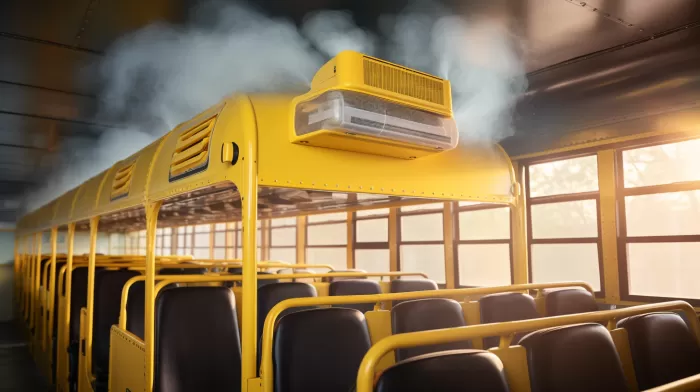Children who ride school buses are unknowingly exposed to high levels of air pollution that can harm their hearts and lungs. However, researchers at the UCLA Fielding School of Public Health have discovered a straightforward solution to drastically reduce their exposure to these harmful pollutants.
Experts designed an air filter for school buses that has proven to eliminate 88 percent of pollutants within the vehicle. The high-efficiency cabin air (HECA) system can significantly improve the health of the 25 million U.S. children who use school buses daily.
It is important to note that children are more susceptible to the effects of air pollution than adults. This is because they take faster breaths and their hearts, lungs, and immune systems are still immature and developing.
When scientists studied the air quality inside school buses, they found it worse than the air along California freeways. On the other hand, buses utilizing the HECA system were found to have air as pollution-free as the air on the beach in Santa Monica, California.
Yifang Zhu, a researcher from the UCLA Fielding School of Public Health, states, “During school bus commuting, children can be exposed to significantly greater levels of air pollutants than a typical resident in the South Coast air basin.” Numerous studies have demonstrated that exposure to high levels of vehicle pollution is associated with pulmonary and cardiovascular health risks, including oxidative stress, mitochondrial damage, and acute pulmonary inflammation.
Researchers conducted air tests inside and outside six school buses while these were stationary and while driven on major roadways in the Los Angeles area. Particle tests were carried out, inspecting black carbon and fine and ultrafine particles. The experts have concluded that the developed HECA filtration system has great potential to substantially reduce children’s exposure to vehicle pollutants while commuting inside school buses.
##Addressing an Urgent Issue Amidst Climate Change
Air pollution continues to be a pressing issue worldwide. It contributes to numerous health problems such as respiratory infections, heart disease, COPD, stroke, and lung cancer. In younger individuals, it affects cognitive development and reduces school performance. Protecting children from air pollution and reducing their exposure risks both inside and outside school buses is crucial for their overall well-being.
As nations continue to battle climate change, adopting the high-efficiency cabin air system in school buses can make a significant impact on reducing children’s exposure to air pollutants. Furthermore, educating parents and school districts on the threats of air pollution and implementing actions to mitigate its effects are necessary steps in lowering the risks of long-term health consequences.
##Additional Measures for Ensuring Clean Air
Aside from implementing the HECA system in school buses, there are other practical steps that parents and school districts can consider taking to reduce children’s exposure to air pollution. For instance, choosing walking or cycling routes that avoid heavily congested streets can lower exposure levels. Planting trees and hedges outside homes and schools also provide a barrier to pollution, helping to clean the air surrounding these environments.
Indoor air quality should not be neglected either. Ensuring proper ventilation, using air purifiers, and regularly cleaning air filters in cooling and heating systems can help maintain clean air indoors. Additionally, avoiding household products, such as pesticides and harsh cleaning products, that contribute to indoor air pollution is another way to protect children’s health.
##Prioritizing Children’s Health Amidst Environmental Challenges
As the world continues to grapple with climate change and air pollution, it’s crucial that practical measures are put in place to protect children’s health. Investing in the high-efficiency cabin air (HECA) system is a small yet significant step in ensuring cleaner air for children during their daily journeys.
However, this is just one step in combating air pollution. It’s essential to promote and implement a collective effort in creating a cleaner and healthier environment for children, which includes supporting solutions such as renewable energy and sustainable transport. By understanding the impact of air pollution and the risks it poses, parents, schools, and communities can work together to ensure cleaner air for everyone’s well-being and a safer world for future generations.



